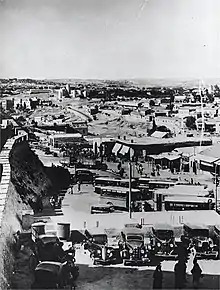St Andrew's Church, Jerusalem
St Andrew's Church, also known as the Scots Memorial Church, is a church in Jerusalem built as a memorial to the Scottish soldiers who were killed fighting the Turkish Army during World War I, bringing to an end Ottoman rule over Palestine. It is a congregation of the Church of Scotland.


History

One of the main campaigners for the memorial church was Ninian Hill, an Edinburgh shipowner and Church elder. The foundation stone was laid by Field Marshal Lord Allenby on 7 May 1927 and the church was opened in 1930 with Ninian Hill as its first minister.
The Church was much used by Scots serving in the Mandate administration and soldiers serving with Scottish Regiments stationed in Palestine during the Mandate and the Second World War. After the out break of hostilities in 1948 the church was on the front line. Firstly between Jewish forces in West Jerusalem and Arab irregulars in the Old City, later between the Jordanian Arab Legion soldiers and the Israeli army. The minister, William Clark Kerr, remained in the Church throughout this period, ringing the church bell and conducting Sunday services. In one cable to Edinburgh he wrote: "All night battle round the building... St Andrew's Cross (flag) on both church and manse. If that is not enough will try Rampant Lion."[1]

The current Minister is Rev Dr John McCulloch.[2]
The first Scottish missions to the Galilee started in the mid 19th century, and for the next 100 years Scottish Presbyterians were actively engaged in the fields of education and medicine. Psalm 122 is sung every May at the General Assembly of the Church of Scotland held in Edinburgh :
- "Pray that Jerusalem may have
- peace and felicity:
- let them that love you and your peace
- still have prosperity."
- (first verse of Hymn 82 in the Church of Scotland hymnary, fourth edition)
Following World War I, the British Mandate in Palestine lasted until 1948. This substantially increased the number of Scots living and working in Jerusalem. Following the end of the mandate and the establishment of the State of Israel, the number of Scots working in Jerusalem dropped drastically. The church’s prominent location very near the 'Green Line' politically dividing Jerusalem, cut it off from the Christian community in the Old City. The building still bears marks from fighting during the Six-Day War of 1967.
The church is open for services on Sundays and runs a guesthouse.[3]
Other facilities
The Church of Scotland also runs the Tabeetha School (an English language school at Jaffa that accepts Christian, Jewish and Muslim children) and the refurbished Church of Scotland Centre and Scots Hotel at Tiberias.[4]
See also
| Wikimedia Commons has media related to St Andrew's Church, Jerusalem. |
- Albert Clifford Holliday (1897–1960), British architect whose company drew the plans of the building
- List of Church of Scotland parishes
- Scots Hotel
- Christianity in Israel
References
- Kernohan, R.D., The Road to Zion: Travellers to Palestine and the Land of Israel. 1994. ISBN 0-8028-0889-1. pages 138,139.
- Dunlop, Walter T. (2014) Faith Rewarded: The Story of St Andrew's Scots Memorial, Jerusalem. FastPrint Publishing. ISBN 978-178456-111-6. p. 237
- Scottish guesthouse
- Scots Hotel: Why the Church of Scotland has a Galilee getaway